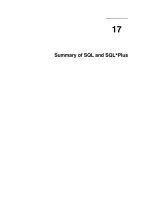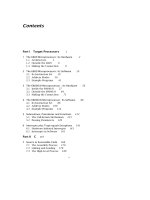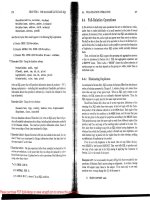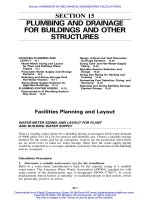Tài liệu EXPERIENCE OF THE INSTITUTE OF ENERGY IN THE PREPARATION OF THE RENEWABLE MASTER PLAN docx
Bạn đang xem bản rút gọn của tài liệu. Xem và tải ngay bản đầy đủ của tài liệu tại đây (193.85 KB, 12 trang )
Institute of Energy
RURAL RENEWABLE ENERGY WEEK IN HANOI
EXPERIENCE OF THE INSTITUTE
OF ENERGY IN THE
PREPARATION OF THE
RENEWABLE MASTER PLAN
Presented by: Nguyen Duc Cuong
Institute of Energy
Hanoi, 3/2008
Institute of Energy
Contents of Presentation
1. Introduction
2. Main Contents of RE Master Plan
and Some Preliminary results
3. Experience
Institute of Energy
1. Introduction
9 VN is relatively endowed with multiform renewable energy (RE) resources which are
distributed through-out the country. They can be exploited for production of energy to
meet rapidly increasing energy demand as well as environmental protection.
9 Main RE resources in VN are small hydro power, biomass energy, wind energy, solar
energy, and geothermal energy.
9 So far, even the high potential of RE resources, their contribution in electricity
production in Vietnam is still negligible.
9 The Government of VN recognized important role of RE in sustainable energy
supplying in general and electricity in particular for rural off-grid areas.
¾
The electricity Law require support to be provided to electricity generation from RE
¾ Decision No.110/2007/QD-TTg, it plans to install the grid connected RE with 4051 MW
¾ Decision No.1855/QD-TTg, it sets up the target with share of RE (3%-2010; 5%2020)
9 MoIT has commissioned the preparation of Strategy, Master Plan on RE
Development for the Period up to 2015 with Outlook to 2005, and first draft report has
been prepared by Institute of Energy
Institute of Energy
2. Main Contents of RE Master Plan and Some Preliminary results
1. Present status of RE development
1.1. Existing development in VN
1.2. International experience
2. Evaluation of VN’s RE resources
(small hydropower; biomass/biogas energy, bio- fuel, wind energy,
solar energy, geothermal energy and tide)
3. The potential role of RE in the National energy supply –demand balance
4. RE strategy development
5. Scenarios for RE development
6. Strategy environmental assessment
7. Investment programme and Economic analysis
8. Development RE Policies and implementation measures
9. Conclusions and recommendations
2.1. Organization of RE MP
Institute of Energy
Present status review
Share of RE electricity in total power generation in Vietnam
Power resource Capacity (MW) Share (%)
Traditional 11,360 97.65
Coal fired TPP 1,427 12.28
Oil fired TPP 573 4.93
Gas turbine 4,450 38.25
Diesel 615 5.29
Large hydropower 4,227 36.34
Renewable 273.2 2.35
Wind power 1.2 0.01
Small hydropower 121.0 1.04
Solar power 1.0 0.009
Biomass power 150 1.29
Total 11,633.2 100.000
Institute of Energy
Solar Energy
¾ Over 100 solar measurement stations throughout the country
¾ Average solar radiation is 5 kWh/m
2
per day.
¾ Average number of sunny hours is about 2000-:-2500 hours/year.
Wind Energy
¾ Wind energy density: 800 – 1400 kWh/m
2
.year on islands
¾ 500 -1000 kWh/m
2
.year in coastal areas and highlands
¾ Other areas: less than 500 kWh/m
2
.year.
Biomass Energy
¾ Agricultural residues is over 60 million tons (equivalent
more than 10 million tons of oil).
¾ Types of biomass can be exploited at the industrial
scale: rice husks; leaves, top of sugar canes &
baggage; coffee husks and wood residues.
Assessment on potential of renewable energies
Institute of Energy
Biogas energy
¾ Biogas resources: landfills, animal excrements, agricultural residues
¾ 80,000 biogas plants have been constructed
¾ Biogas potential is about 10 billions m3/year.
Small Hydropower Energy
¾ Technical potential > 4000 MW
Geothermal energy and other types (tide, ocean waves )
¾ Potential of geothermal energy resources: 200- 340 MW.
¾ The renewable energy type such as tide and sea waves are
in the stage of potential assessment.
Institute of Energy
Development scenarios
Three scenarios for renewable electricity developed (Low, base case and high)
Three scenarios for renewable heat (modern biomass applications, biogas
digesters, and solar water heaters developed
NLTT giai đoạn 2006-2025
Kịch bản Cao
0
1000
2000
3000
4000
5000
6000
2006
2007
2008
2009
2010
2011
2012
2013
2014
2015
2016
2017
2018
2019
2020
2021
2022
2023
2024
2025
Năm
Công suất (MW)
Thuỷ điện nhỏ Năng lượng sinh khối
Khí sinh học Năng lượng mặt trời
Điện gió Địa nhiệt
Nhiên liệu sinh học Thuỷ triều
Rác thải sinh hoạt
Three scenarios Proposal
for producing electricity
from RE
1. Base case scenarios:
4051 MW
2. High scenarios:
4790 MW
3. Low scenarios:
2267 MW
Institute of Energy
Alternative traditional energy by RE (high scenarios)
TT Type of RE 2010 2015 2020 2025
1 Morden biomass stoves 273 750 574 000 821 250 1 642 500
2 Biogas technologies 255 500 511 000 876 000 1 095 000
3 Solar Water heaters 8 600 21 500 43 000 107 500
4 Bio-fuel 100 000 250 000 1 000 000 1 800 000
Total 637 850 1 356 500 2 740 250 4 645 000
Unit: TOE
Identify barriers and issues for RE development
+ Policies/regulation and implementation measures
+ Institution framework
+ high cost (investment and product)
+ CDM
Institute of Energy
3. Experience
Advantages:
1. Vietnam has larger potential and diversified RE resources
2. Government set up development plan for RE
2.1. Renewable electricity development
Decision No110/2007/QD-TTg, Renewable electricity planned as below:
From 2006-2015: Installed new 2451 MW, average: 241 MW/year
From 2016-2025: Installed new 1600 MW, average: 160 MW/year
2.2. Bio-fuel development
From 2007-2010: Gasohol E5: 100000t/year, Bio-diezel B5: 50000t/year
with 8% gasohol demand will replaced by E5
From 2010-2015: 20% gasoline & diezel demand will replaced by E5 & B5
3. Supporting strong from MoIT (development of RE Master Plan)
Institute of Energy
Disadvantages and limitations:
1. First new RE Master Plan in VN
2. Financing is limited due to regulation
3. Time is limited
4. Inadequate database
5. Lack of information, analysis, and assessment on potential RE
resources, cost, and benefits of environment
6. Lack of manpower
Institute of Energy
THANK YOU FOR YOUR
ATTENTION!









